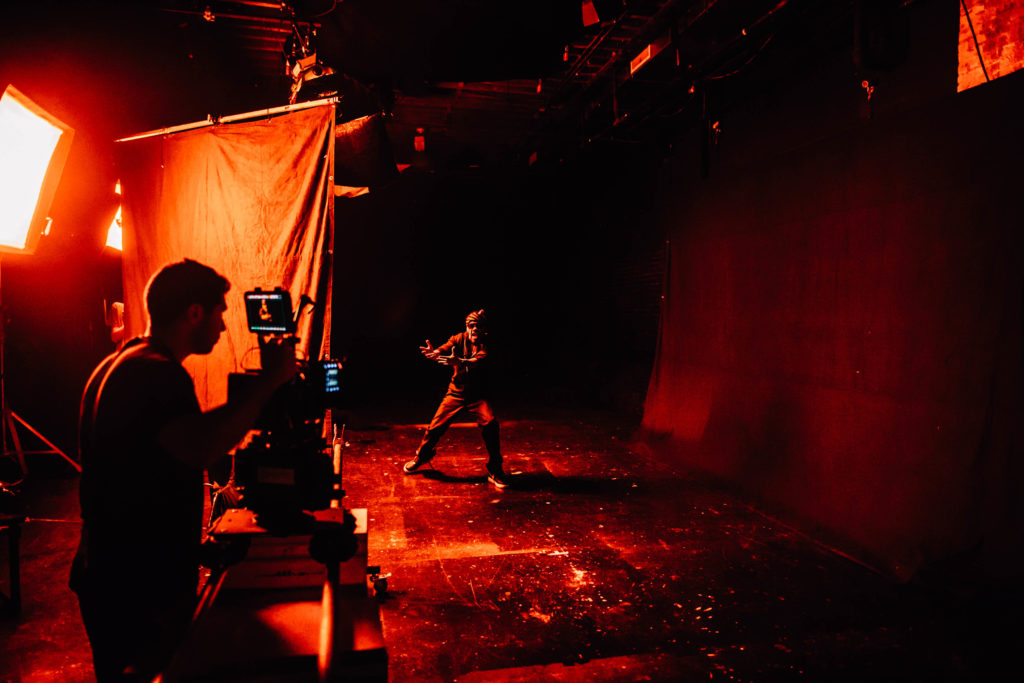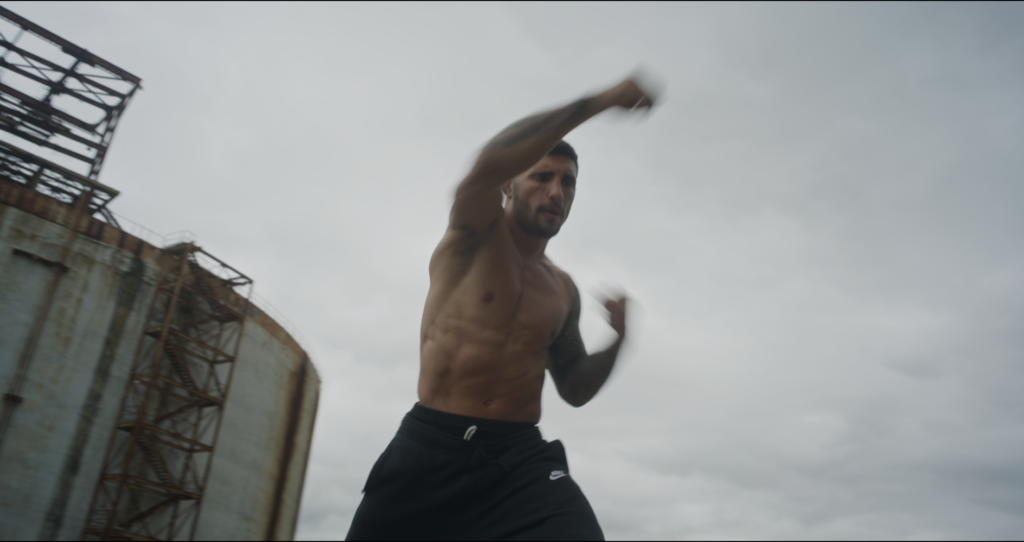September 24, 2019
6 min read
Growing up with a love of shooting 35mm still film, New York-based DP Nick Dabas did not follow the traditional road in becoming a cinematographer. After graduating college with a degree in graphic design, instead of becoming a graphic designer, he purchased high-end digital photography gear and began work as a commercial photographer. But after spending years as a successful photographer, he still wasn't satisfied so he sold all of his photo equipment and bought a VariCam LT.
“At the time, I didn’t budget for lights but the LT was a very easy camera to work with, especially with lower budgets,” explains Dabas. “I did some testing with the camera and got great results and feedback. A director reached out to me to shoot a Bloomingdales commercial. That was the first main piece I shot with the camera and everyone loved the look. The camera gave me more confidence on set because of its latitude and color space.”

DP Nick Dabas shooting a Wu-Tang Clan video with the VariCam LT.
After the commercial spot, Dabas went on to co-shoot a music video for the Wu-Tang Clan. (Like the hip-hop group, Dabas hails from Staten Island.) His cinematography work on that music video helped him land numerous music videos, commercials, and fashion jobs.
The VariCam Look
Dabas is both a VariCam 35 and LT owner and loves the VariCam’s flexibility and color palette. For all of his projects, Dabas captures AVC-Intra V-Log files. “There’s really no bad cameras now but there’s just different boxes of crayons and each box has different crayons,” he explains. “The unique thing I love about the VariCam is that it has its own look. In my opinion, it’s a very neutral look but at the same time, it hits different color palettes that other cameras don't hit.”
He only sets the LT's color temperature values at 3200, 4300 or 5600K because he feels he's able to work faster and it's more accurate to work with in the color grade when working in mixed color temperatures. “In working with the VariCam’s Dual ISOs, I normally shoot the camera at 500 dialed down from 800 base during the day,” says Dabas. “The sun is very contrasty and the VariCam offers lower highlights and more shadow detail when you’re shooting at 500 ISO. On a contrasty day, you want a little more shadow detail, so I found that to be a nicer look. When I move back inside, I go back to native 800, or 5000 if it’s low light. I know a lot of people dial down from 5000. Instead of dialing down from the 5000 base, I’d rather ND filter in front just because you’re retaining all 14+ stops of dynamic range.”

Frame grab from an NBA jersey campaign that Dabas shot on VariCam.
Shooting with the Lumix S1H
The Lumix S1H contains a 24.2MP full-frame MOS sensor and lets you capture full area (3:2) 6K 10-bit 24-fps, offers Dual Native ISOs, and a wide 14+ stops of dynamic range. For the global launch of the Lumix S1H, Dabas was one of the first U.S. filmmakers to shoot a project with the mirrorless camera, along with filmmakers Alicia Robbins, Carisa Dorson, Peter Hamblin, Jacob Schwarz, and David C. Smith. With the S1H, he created the short film, The Mixup, an action-packed chase film shot in mainly available light, compact prime lenses, and small stabilization rigs. Dabas and his small crew (three to four people) shot the film in extreme 105-degree heat, as well as in a dangerous lightning storm.
“The main purpose of my piece was to target the person who’s going to buy this camera for $4,000 dollars,” explains Dabas. “They’re not going to have a 40 or 50 thousand budget so I wanted my production to be very realistic and easy to relate to.”
Previously not a big fan of using mirrorless cameras for cinema projects, Dabas became intrigued after learning that VariCam lead designer Taka Mitsui was involved in helping the S1H match the VariCam in many of its features. Dabas received an early prototype and shot with it for a week comparing the image quality to his VariCams. “The dynamic range curve that the S1H has is actually pretty amazing,” reveals Dabas. “It shoots slightly differently than the VariCam. At 800 ISO, the VariCam is seven stops over and seven stops under. The S1H is six stops over and eight under, so you actually retain great shadow detail. On set, I made sure that my highlights were holding since I could always fill the shadows in with light. Once you learn and become comfortable with the S1H, and you can easily match it to the VariCam. The color that is reproduces is beautiful and is very similar to the VariCam.

Dabas checking the S1H's frame with his crew for The Mixup.
Dabas feels the S1H is an ideal match on his VariCam shoots because he can put it in places the VariCam cannot go. “You can utilize the S1H for a quick car rig set-up or capture a cool shot inside a refrigerator – situations where you wouldn’t put a VariCam in because it can’t fit,” he explains. Also, the S1H’s V-Log is so neutral, you can really cut any camera to it.”
Maximizing Dual ISOs
For The Mixup, Dabas shot all of his daylight scenes at native 640 ISO and used screw-on ND filters. For night scenes, he shot at 4000 ISO, which he thought had a beautiful and clean look. “The 4000 with the full frame is really insane,” he says. “It’s full frame, 4K, 10-bit, 400-Mbps but it also has a Super 35 mode. If I’m on a zoom lens shooting a documentary, a 16-35mm full frame, in Super 35 mode, it’s now like a 24 – 55mm so I have more reach with a single lens. Essentially I have a digital zoom that’s a real optical zoom and you’re not losing quality but rather punching into the sensor. The 6K sensor coming down to 4K is a beautiful 4K. I would say it looks sharper but it’s hard to explain. People will need to test the camera out to see how beautiful the color is.”

Frame grab of pro MMA fighter Santo Curatolo in The Mixup, shot with the S1H.
Dabas employed his own Leica Summilux-M lenses with an M- to L-mount adaptor. He generally shot with a 28mm, 35mm, 50mm, and his favorite 40mm from the 1970s. “I love those lenses because they’re super tiny,” he says. “For me, one of the main purposes of the camera is to be super nimble and small. Leicas have a very classic look and it reminds me of all of the photos I used to take with my Leica still camera. You can open to a 1.4 or 2.0 and it has a beautiful bokeh. For people using the S1H, you have a lot of lens choices.”
For The Mixup, Dabas didn’t go below an f/4. Although he wanted to maximize the S1H’s shallow depth of field, he wanted also wanted to get a sense of his locations. “I didn’t want to shoot at a 2.0 because I would lose our beautiful landscape or show viewers where we were in the streets,” he reveals. Dabas shot mainly in available light but for a nighttime staircase chase scene, he lit the scene with Quasar tubes and a single ARRI L7-C Fresnel light.
According to Dabas, the S1H is an extremely versatile camera. “If the S1H is your only camera you’re going to shoot with, it can definitely be an A-camera,” he says. “The VariCam is more of a proper cinema camera because you have all the functionality right there on set. With the S1H, you’ll need to build it out with a cage, but I think the images speak for themselves. It’s a pretty amazing little camera.”
For more info on DP Nick Dabas, visit his website here.
For more info on the VariCam LT, click through here.
For more info on the Lumix S1H, click through here.
![]()
